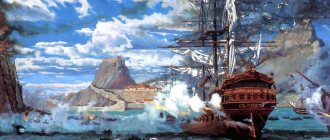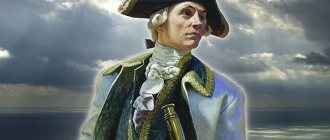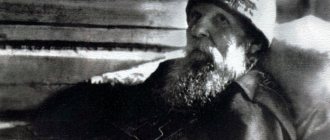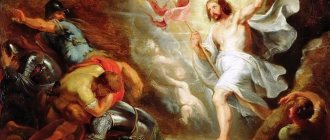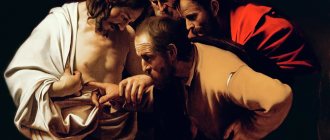P. Bazhanov “Portrait of Admiral F.F. Ushakova"
Out of 43 naval battles, he did not lose a single one...
Under his command, not a single Russian ship was lost, not a single sailor was captured by the enemy.
Fedor Fedorovich Ushakov was one of the founders of the Black Sea Fleet, and from 1790 - its commander. Thanks to a number of major victories over the Turkish fleet, Russia was able to establish lasting peace in Crimea. Ushakov successfully led the Mediterranean campaign of Russian ships during the war against France, which aroused the admiration and envy of the famous English Admiral Nelson. But Ushakov received his first award (Order of St. Vladimir, 4th degree) in 1793 not for military actions, but for his work during the fight against the plague epidemic and for caring for sailors.
Icon of F. Ushakov
In August 2001, Admiral Fedor Fedorovich Ushakov was canonized as a righteous saint and became the heavenly patron of military sailors.
“The strength of his Christian spirit was manifested not only by glorious victories in battles for the Fatherland, but also in great mercy, which even the enemy he defeated was amazed... the mercy of Admiral Feodor Ushakov covered everyone; he was truly a mourner of the people's needs: the subordinate sailors and officers, all the suffering and dispossessed who turned to him, and all the peoples he liberated outside Russia. And he did good to everyone in any way he could, and the people repaid him a hundredfold in return with love. At the same time, he was an ascetic of great virtues, an intercessor and representative for the Russian army” (From the Acts of Canonization).
Childhood and youth
Fedor Fedorovich Ushakov was born on February 13, 1745 in the village of Burnakovo (now Rybinsk district of the Yaroslavl region). The strategist’s father, Fyodor Ignatievich, served as a sergeant in the Preobrazhensky Life Guards Regiment until he received his resignation, and his mother Paraskeva Nikitichna took care of the household.
Portrait of Fyodor Ushakov
The education of the future admiral was carried out by his uncle Theodore of Sanaksarsky and an old fellow villager who served in Peter’s fleet. Since childhood, Ushakov dreamed of the sea, since land fun seemed boring to him.
From a young age, the strategist loved sails and water; there was no more enjoyable activity for him than carving toy ships out of wood. Fellow villagers often came to the Ushakovs’ house to admire the creations of the talented needleworker.
One day, a local hunter, Prokhor, invited Fyodor to go bear hunting with him, and the boy, without a moment’s hesitation, told the man that he would go after the beast only if he met it on the water.
Monument to Fyodor Ushakov near the Museum of Shipbuilding and Fleet in Nikolaev
At the age of 16, parents brought their beloved child to St. Petersburg. In the northern capital, a strong village youth entered the naval cadet corps. It is worth noting that at that time young nobles from noble families were reluctant to join the navy, mainly the children of fellow nobles were trained in this institution.
Ushakov studied science persistently, poring over textbooks until nightfall, and in 1766, after five years of study, he graduated from the corps with honors, receiving the rank of midshipman. At the beginning of his career, the future admiral sailed in the Baltic Sea, and on the eve of the Russian-Turkish War, the talented officer was transferred to the Azov flotilla, where he served for a couple of months.
Interesting facts about life
Ushakov's squadron was rapidly approaching the enemy and, without changing formations customary at that time, attacked the flagship, maneuvered freely, shooting the enemy from a short distance. Recognizing only victories, the naval commander pursued and destroyed all those who did not surrender.
He served in the navy for 44 years, participated in 3 wars, and did not know a single defeat.
He did a lot of charitable work, often donated his money to orphanages, and built hospitals with his own money.
The life of the great son of Russia was similar to monasticism.
Military service
With the outbreak of war, the future invincible naval commander gets his first chance to distinguish himself and uses it. Thus, commanding a sixteen-gun ship, its crew successfully repelled the attacks of the Turks who landed in Balaklava, after which no one doubted his strategic decisions.
It is known that the young officer was entrusted with transferring Baltic military ships disguised as merchant ships to the Black Sea. Fedor also delivered ship timber to the St. Petersburg shipyards, entering into desperate feuds with dishonest contractors.
Naval commander Fedor Ushakov
After this, Ushakov was appointed captain of the imperial yacht. However, proximity to the imperial person did not attract the ambitious naval officer, and Fedor achieved a transfer to a battleship, on which he regularly sailed as part of the squadron on campaigns in the Mediterranean Sea. Later, the naval commander organized the construction of a Black Sea Fleet base in Sevastopol.
Soon, captain first rank Ushakov is appointed commander of the ship, which has just begun to be built at the Kherson shipyard. Before the sailors had time to get to work (at that time they participated in the construction of the ship along with the shipbuilders), a plague epidemic broke out in Kherson.
Ushakov took his team out of the city. There the sailors built ditches, lit fires on all sides and, for preventive purposes, began to wipe themselves with vinegar and crushed herbs. Thanks to the efficiency of Fedor Fedorovich, not a single crew member became infected with the fatal disease. As a result, the construction of the ship was completed.
Monument to Fyodor Ushakov in Kherson
Upon returning to his homeland, the admiral was awarded the Order of St. Vladimir. It is worth noting that Ushakov was awarded not for military merits, not for victories, but for timely ingenuity and resourcefulness.
Then the strategist set himself a new task - at all costs to make the sailors of his ship the most experienced team of the Russian combat fleet. Ushakov developed a unique training method: a gun was mounted on a swinging swing, and crew members had to hit a sail attached to a raft not far from the ship.
Thanks to this course, Ushakov ensured that his sailors perfectly mastered the art of conducting massive fire. On the occasion of the emergence of a new force capable of competing with the Ottoman Empire for power in the Black and Mediterranean Seas, Empress Catherine II hosted a reception for foreign delegations in Simferopol.
Contemporaries in the age of high technology cannot understand how difficult it was to navigate the sea at that time. Then sailors, in order to steer the ship without deviating from a given course, paid attention to the strength and direction of the wind, and also observed the current. During battles, Ushakov not only monitored the amount of ammunition, but also controlled the actions of each crew member.
It is also worth noting that Fedor Fedorovich was the first in history to violate all the laws of naval combat. Then there was an unspoken code of battle, which stated that before the battle, opponents should approach each other within the distance of a pistol shot, line up and only then attack.
Ushakov stated that this was an empty, irrational waste of time and that the emphasis should be placed on the main ship, first of all destroying it. This tactic helped Fedor Fedorovich win the battle with the Ottoman fleet. Then the admiral countered the enemy’s numerical superiority with a new strategy - and he was not mistaken. The Russian fleet, having reformed on the move, cut off the main ships of the Turks, for which they were not prepared.
Admiral Fedor Ushakov
The enemies, in panic, began to raise anchors and cut ropes. Thus, having destroyed the enemy command, Ushakov’s fleet one by one defeated the entire Turkish squadron.
After this victory, Field Marshal General, Prince Grigory Potemkin became the patron of the eminent admiral and in a letter to the Empress praised his brave protégé. In 1790, Potemkin, with the approval of Catherine II, entrusted Ushakov with the leadership of the entire Black Sea Fleet, and Fyodor Fedorovich, raising the flag on the ship “St. Paul”, set off with the fleet to the shores of Turkey. There he bombarded Sinop, destroyed 26 enemy ships, and then repelled a Turkish attack at the Kerch Strait.
Monument to Fyodor Ushakov on Cape Kaliakra
It is noteworthy that the defeated enemies often asked Ushakov for mercy, sending envoys and offering money. The admiral never destroyed human destinies, but he did not spare enemy ships.
The captain understood that peace could only be concluded after all the ships of the Turkish fleet were defeated. The battle that made his name immortal took place on July 31, 1791, in the Black Sea, near Cape Kaliakra (northern Bulgaria). Then the commander-in-chief of the Turks declared that he would take Ushakov prisoner, not yet realizing that his entire fleet would fall.
The Ottomans were waiting for Russian ships near the shore on which the battery was installed. Fedr Fedorovich, famous for often conducting reconnaissance before battle, knew about the location of the enemy and about the installation. As a result, he bypassed the Turks, passing between the shore and their ships, caught a fair wind and defeated the enemy fleet.
Cathedral of the Holy Righteous Warrior Theodore Ushakov in Saransk
The peace treaty concluded with Turkey assigned the entire northern Black Sea region, including Crimea, to Russia. While Alexander Suvorov was winning victories on land, Ushakov was proving to the world that Russia is the rightful owner of the sea.
In August 1798, Paul I sent Ushakov’s Black Sea squadron to the Ionian Islands (at that moment the French dominated their shores) so that he could consolidate the Russian presence in the Mediterranean Sea. This time, Fedor Fedorovich also had his recent rival on his side - the Ottoman Empire.
True, this time too the admiral demonstrated incredible resourcefulness. According to legend, Ushakov dressed his henchmen in ladies' clothes, and when the French saw ladies landing on the shore with guns, they declared that they do not fight with representatives of the weaker half of humanity and raised a white flag. As they got closer, the soldiers realized that they had been deceived.
Stella for Fyodor Ushakov on the island of Corfu
This was followed by the capture of the fortress of Corfu (the structure fell in one day), after which the liberation of the Ionian Islands from the French presence was completed. For this operation, Fedor Fedorovich was elevated to the rank of admiral, and the Turkish Sultan presented the strategist with a sable fur coat and a diamond feather.
The founder of the Russian fleet is Peter I, but after the death of the reformer, his life’s work experienced hard times, and when Europe improved its naval art, Russia underestimated the strength and importance of the naval army. This continued until Fyodor Ushakov took the helm of the dying fleet, who brought his country many victories.
Russo-Turkish War 1787–1791
Perhaps the most famous battle of Ushakov was the battle near the island of Fidonisi. The combat power of the Turkish squadron was more than twice that of the Russian one, and the number of battleships was seven times greater. Nevertheless, Ushakov managed to line up the ships so that the most decisive attack came on the Turkish flagship under the control of Hassan Pasha. Attempts to support him were immediately stopped by Russian frigates. Being hit, the ship went to the Rumelian shores, and the Sevastopol squadron returned to its home port for repairs.
In 1788, Ushakov was appointed commander of the Sevastopol squadron and port, and a year later he was promoted to rear admiral.
Death
The last place of Admiral Ushakov’s earthly life was the quiet village of Alekseevka in Temnikovsky district, near the Sanaksar Nativity of the Mother of God Monastery. It is known that during the Patriotic War of 1812, Fyodor Fedorovich was elected head of the Tambov province militia, but due to illness, he resigned from the position, devoting himself to prayers.
Grave of Fyodor Ushakov
The naval commander died on October 2, 1817 on his estate, in the village of Alekseevka. The funeral service was held for the righteous warrior in the Transfiguration Church in the city of Temnikov. When the coffin with the body of the deceased admiral, in front of a large crowd of people, was carried out of the city in their arms, they wanted to put it on a cart, but the people continued to carry it all the way to the Sanaksar monastery, where the admiral was buried.
In 1953, director Mikhail Romm made the films “Admiral Ushakov” and “Ships Storm Bastions,” based on the life of a talented strategist.
Personality characteristics according to the memoirs of contemporaries
Many people who communicated with F. Ushakov noted his extraordinary simplicity in communication, goodwill and directness, combined with courage, courage, enormous willpower and endless faith in God. According to eyewitnesses, in any battle Ushakov ordered to lead his ship to the epicenter of the battle, showed the sailors and officers a personal example of courage and courage, and himself gave combat commands.
Defeated enemies always asked Ushakov for mercy, sent envoys, offered rich ransoms, and Fyodor Fedorovich spared the enemies. They talked about him as a very pious and kind person, at the same time hot-tempered, persistent and strict with the officers, but fair, loved and deeply respected by Russian sailors and Turks. Ushakov's eminent contemporaries Suvorov and Nelson emphasized his independence in actions and decisions and unprecedented courage.
Canonization
After the 1917 revolution, the Sanaksar monastery was closed, and the chapel built over the admiral’s grave was destroyed.
Order of Fyodor Ushakov
Joseph Vissarionovich Stalin established the Order of Ushakov in 1943, but to create the award, an image of Fyodor Fedorovich was required. None of the biographers or artists knew how to reliably portray the admiral, and, as we know, the use of an unreliable image in state symbols is unacceptable.
Therefore, in 1944, a state expedition to the Sanaksar monastery took place, in which the admiral’s burial was opened. Subsequently, based on the found skull, the appearance of Ushakov was restored, and the grave of the eminent admiral, along with the remains of the monastery complex, was taken under state protection.
Icons by Fyodor Ushakov
In August 2001, the Russian Orthodox Church elevated Theodore Ushakov to the rank of saint. Now icons depicting the talented naval commander are kept in churches and monasteries.
Mediterranean trek
In 1798, Emperor Paul I gave Ushakov an order to send the Black Sea flotilla to the Ionian Islands, captured by the French, and strengthen Russian power in the Mediterranean Sea. It is noteworthy that this time Ushakov’s ally became his recent enemy - the Ottoman Empire.
The Russian naval commander managed to liberate the Mediterranean archipelago from the presence of the French in the shortest possible time. At the end of the successful expedition, Fedor Fedorovich was elevated to the rank of admiral, and the Turkish Sultan presented him with rich gifts as a sign of respect.
Memory
- A bay in the southeastern part of the Barents Sea and a cape on the northern coast of the Sea of Okhotsk are named after the naval commander.
- In Temnikov there is a local history museum named after Ushakov
- In Moscow there is Admiral Ushakov Boulevard and the metro station of the same name
- In St. Petersburg, an embankment and a bridge are named after Admiral Ushakov, and a monument was erected
- In October 2002, in Greece, on the island of Corfu, a monument to Admiral Fyodor Ushakov was erected
- In Kerch on April 11, 2009, the day the city was liberated from the Nazi invaders, a monument to the admiral was erected
- In Kaliningrad, a naval institute is named after the admiral
- In 2015, a monument to Admiral F. F. Ushakov was opened in Tambov, at the intersection of Sovetskaya and Lermontovskaya streets
- In the city of Rybinsk, in the vicinity of which the admiral’s homeland is located, his bust was erected. On April 29, 2016, the boulevard received his name. A museum is also open.
Saint Admiral's Awards
F. F. Ushakov was awarded the following orders:
- St. George 2nd class (1790) and 4th class (1788);
- St. Vladimir 2nd (1790), 3rd (1788) and 4th (1785) degrees;
- St. Alexander Nevsky (1791);
- Saint Januarius (Kingdom of Naples, 1799).
It is marked:
- Commander's Cross of St. John of Jerusalem (1798);
- chalk (Ottoman Empire, 1799);
- diamond signs to the Order of St. Alexander Nevsky (1798);
- golden weapons (Republic of the Seven Islands).
